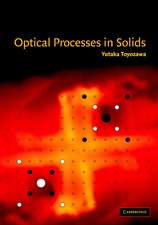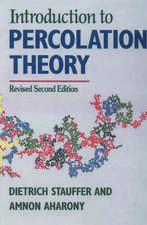Contribution of Clusters Physics to Materials Science and Technology: From Isolated Clusters to Aggregated Materials: NATO Science Series E:, cartea 104
Editat de Joel Davenas, P.M. Rabetteen Limba Engleză Paperback – 8 oct 2011
Din seria NATO Science Series E:
- 24%
 Preț: 1570.70 lei
Preț: 1570.70 lei -
 Preț: 397.76 lei
Preț: 397.76 lei -
 Preț: 386.81 lei
Preț: 386.81 lei - 20%
 Preț: 346.24 lei
Preț: 346.24 lei -
 Preț: 424.33 lei
Preț: 424.33 lei - 18%
 Preț: 1224.18 lei
Preț: 1224.18 lei - 18%
 Preț: 1836.63 lei
Preț: 1836.63 lei - 18%
 Preț: 1229.28 lei
Preț: 1229.28 lei -
 Preț: 381.00 lei
Preț: 381.00 lei - 18%
 Preț: 1841.36 lei
Preț: 1841.36 lei - 5%
 Preț: 367.28 lei
Preț: 367.28 lei -
 Preț: 407.19 lei
Preț: 407.19 lei - 18%
 Preț: 1838.38 lei
Preț: 1838.38 lei -
 Preț: 420.28 lei
Preț: 420.28 lei -
 Preț: 399.29 lei
Preț: 399.29 lei -
 Preț: 398.74 lei
Preț: 398.74 lei - 18%
 Preț: 3026.13 lei
Preț: 3026.13 lei -
 Preț: 388.90 lei
Preț: 388.90 lei - 5%
 Preț: 391.06 lei
Preț: 391.06 lei - 18%
 Preț: 1228.62 lei
Preț: 1228.62 lei - 18%
 Preț: 1229.73 lei
Preț: 1229.73 lei - 18%
 Preț: 1234.46 lei
Preț: 1234.46 lei - 5%
 Preț: 3532.05 lei
Preț: 3532.05 lei - 18%
 Preț: 1840.11 lei
Preț: 1840.11 lei - 5%
 Preț: 378.80 lei
Preț: 378.80 lei - 18%
 Preț: 1227.84 lei
Preț: 1227.84 lei -
 Preț: 392.75 lei
Preț: 392.75 lei -
 Preț: 395.63 lei
Preț: 395.63 lei - 18%
 Preț: 2489.30 lei
Preț: 2489.30 lei - 5%
 Preț: 1429.27 lei
Preț: 1429.27 lei -
 Preț: 396.02 lei
Preț: 396.02 lei - 5%
 Preț: 2142.61 lei
Preț: 2142.61 lei - 18%
 Preț: 3049.16 lei
Preț: 3049.16 lei - 18%
 Preț: 1844.54 lei
Preț: 1844.54 lei -
 Preț: 403.53 lei
Preț: 403.53 lei
Preț: 409.30 lei
Nou
Puncte Express: 614
Preț estimativ în valută:
78.32€ • 82.36$ • 64.71£
78.32€ • 82.36$ • 64.71£
Carte tipărită la comandă
Livrare economică 17 aprilie-01 mai
Preluare comenzi: 021 569.72.76
Specificații
ISBN-13: 9789401084444
ISBN-10: 9401084440
Pagini: 664
Ilustrații: XV, 646 p.
Dimensiuni: 155 x 235 x 35 mm
Greutate: 0.92 kg
Ediția:Softcover reprint of the original 1st ed. 1986
Editura: SPRINGER NETHERLANDS
Colecția Springer
Seria NATO Science Series E:
Locul publicării:Dordrecht, Netherlands
ISBN-10: 9401084440
Pagini: 664
Ilustrații: XV, 646 p.
Dimensiuni: 155 x 235 x 35 mm
Greutate: 0.92 kg
Ediția:Softcover reprint of the original 1st ed. 1986
Editura: SPRINGER NETHERLANDS
Colecția Springer
Seria NATO Science Series E:
Locul publicării:Dordrecht, Netherlands
Public țintă
ResearchCuprins
Properties of Clusters in the Gas Phase.- 1. Introduction.- 2. Cluster production.- 3. Mass spectrometrie detection.- 4. Experiments on clusters in the gas phase.- 5. Laser spectroscopy of free clusters.- 6. Future developments.- Metal Cluster Beams and Electron Diffraction: Deviations from the Bulk States of Matter.- 1. Introduction.- 2. The cluster nucleation process.- 3. Cluster beams.- 4. Cluster electron diffraction.- 5. Metal cluster results.- Generation of Beams of Refractory Metal Clusters.- An Introduction to the Field of Catalysis by Molecular Clusters.- 1. An introduction to molecular clusters.- 2. Catalysis by molecular clusters.- Quantum Chemistry for Metal Clusters.- 1. Generalities — cluster science.- 2. Quantum chemical methods.- 3. Comparisons of Hartree-Fock with X? (LSD) results.- 4. Electronic and magnetic structure of transition metal clusters.- 5. Concluding remarks — need for experiments on isolated clusters.- Electronic Structure of Metal Clusters.- 1. Introduction.- 2. Results.- 3. Experimental results.- Characterization of Supported Metal Particles in Heterogeneous Catalysts: I. Studies of high surface area materials.- 1. Introduction.- 2. Strategies for characterization of metal particles on on high surface area supports.- 3. X-ray diffraction and scattering.- 4. Extended X-ray absorption fine structure.- 5. Mossbauer spectroscopy.- 6. Magnetic susceptibility.- 7. Ferromagnetic resonance.- 8. Vibrational spectroscopy.- Characterization of Supported Metal Particles in Heterogeneous Catalysts: II. Studies of low surface area, model materials.- 1. Introduction.- 2. Strategies for characterization of metal particles on low surface area, model supports.- 3. Experimental techniques.- 4. Applications of studies using model supported metalsamples.- 5. Concluding remarks.- Peculiar Aspects of Heterogeneous Nucleation and Growth Processes Related to Metal Supported Catalyst.- 1. Introduction.- 2. Kevnotes for heterogeneous nucleation.- 3. Mass transfer mechanisms.- 4. Epitaxy post nucleation phenomenon.- 5. Miscellaneous.- Formation, Action, and Properties of Clusters in the Photographic Process.- 1. Introduction.- 2. Basic principles of the photographic process.- 3. Theory of the photographic process.- 4. Outlook.- Formation of Clusters in Bulk Materials.- 1. Introduction.- 2. Metal-excess alkali halides.- 3. Experimental methods for the study of colloids.- 4. Nucleation of colloids from F centres.- 5. Growth of colloids.- 6. Particle coarsening.- 7. Formation of clusters by irradiation.- 8. Summary.- Optical Properties of Small Particles in Insulating Matrices.- 1. Introduction.- 2. Optical material properties of small particles.- 3. Optical extinction and dispersion of one particle.- 4. Optical properties of systems of many particles.- to Percolation Theory.- 1. Two examples.- 2. Formal definition — Site percolation — Bond percolation.- 3. Definition and behaviour of the characteristic quantities.- 4. Thermodynamic analogy.- 5. Scaling laws.- 6. Exact results.- 7. Approximate results.- 8. The exponent of the conductivity.- 9. Percolation and macroscopic random media.- Electronic and Transport Properties of Granular Materials.- I. Effective medium theories of transport in inhomogeneous materials.- II. Specific inhomogeneous materials Morrel H. Cohen.- III. The origins of clustering Morrel H. Cohen.- Optical Properties and Solar Selectivity of Metal-Insulator Composites.- 1. Introduction.- 2. Effective medium theories.- 3. Bounds on the effective dielectric permeability.- 4. Size limits for validityof effective medium theories.- 5. Case study one: optical properties and solar selectivity of coevaporated Co-Al2O3 films.- 6. Case study two: electrolytically coloured anodic Co-Al2O3 coatings.- 7. Summary and remarks.- Adhesion and Sintering of Small Particles.- 1. Introduction.- 2. Production of particles.- 3. General observations.- 4. Dynamics aspects of contact.- 5. Other aspects of adhesion.- 6. Sintering of small particles.- 7. Conclusion.- Physics on the Beach or the Theory of Windsurfing.


















